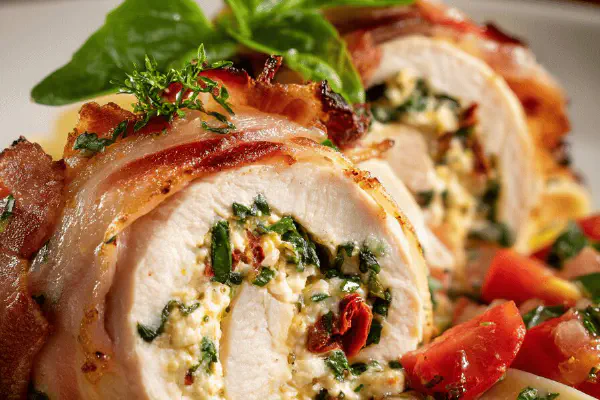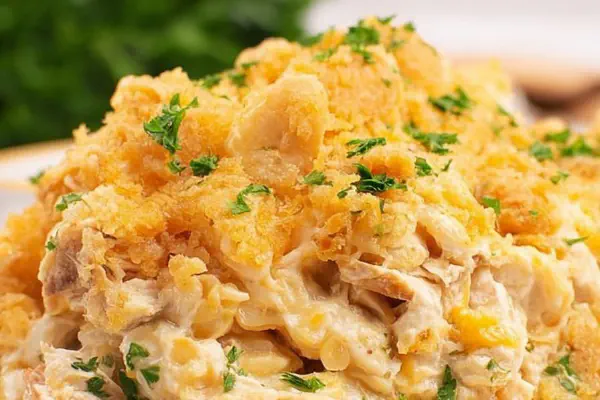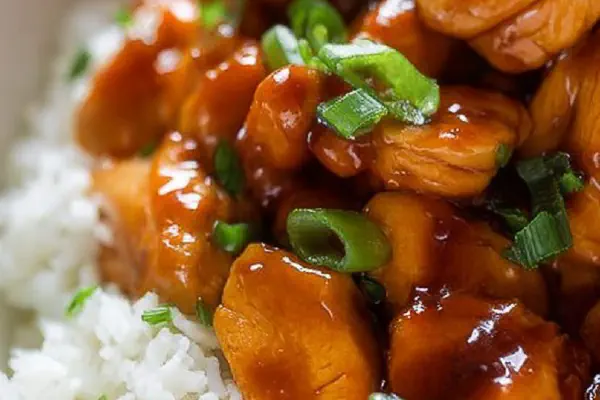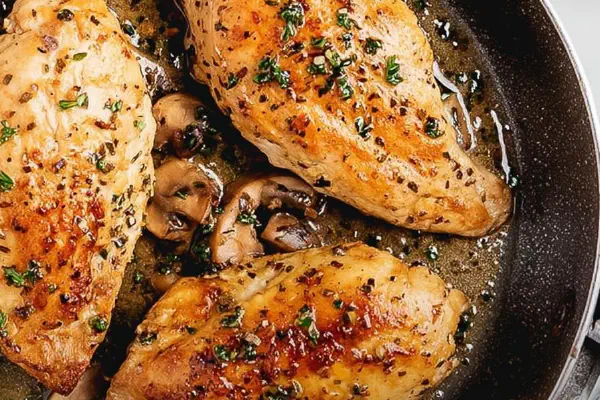Featured Recipe
Mango Chicken Boudreault Style

By Kate
"
Juicy chicken pieces browned in butter with aromatics softened until fragrant. Coconut milk simmers with a touch of brown sugar, melding heat from bird’s eye chili. Fresh diced mango joins late for texture contrast and sweet brightness. Finished with bright green onions and served over rice. Uses chicken thighs and replaces traditional coconut milk with coconut cream for richness, swaps brown sugar for maple syrup. Ginger replaced partially with turmeric for earthiness and color. Cooking times slightly varied to catch true doneness especially with bone-in poultry.
"
Prep:
25 min
Cook:
55 min
Total:
Serves:
4 servings
chicken
fusion
coconut cream
mango
dinner
Introduction
Butter sizzling. Skins crisp rapidly on hot pan. The aroma of turmeric and chili mingling with garlic and shallots, filling the kitchen. Coconut cream pools glossy and fragrant, simmering slowly with maple sweetness balancing the mix. Mango chunks await their turn—too early in the heat and they’ll vanish, too late and they won’t meld. Chicken, cut unevenly, cooks differently, so knowing when the juices run clear is everything. Not about clock watching, but feel and sight guide the process. Scallions tossed on last, like garnish and signal. Simple, no fluff. From precise searing to gentle braising. Layers of flavor in one pan, no fuss. And yes, those burnt bits on the pan bring magic if you scrape right.
Ingredients
About the ingredients
Cuts matter—thighs hold moisture better than breasts. Butter isn’t just fat; it lends nutty flavor and helps crisp skin. Shallots chosen over onions for milder, sweeter bite. Turmeric swapped in for ginger partially; adds color and subtle earthiness without overpowering. Coconut cream richer than milk—adds silkiness but watch heat so it doesn’t split. Maple syrup instead of white sugar for deeper caramel undertones. Mango diced just before finishing prevents it dissolving into sauce losing texture. Chili—remove seeds for low heat or leave for kick. Scallions add brightness at the end, not in cooking or they wilt. Salt early on chicken for better seasoning, helps skin crisp. Butter quantity increased slightly for better browning.
Method
Preheat and Prep
- Position oven rack low, set oven to 185 °C (365 °F). Cut chicken into uneven portions for even cooking; thighs will stay juicy longer than breast meat. Salt pieces liberally and let rest at room temp for 10 min while prepping aromatics.
- Heat butter in heavy skillet that can go in oven. When bubbling and fragrant, lay chicken skin side down. You'll hear that sharp sizzle, skin browning and fat rendering properly. Flip once golden and crisp, approximately 5 min per side. Remove chicken, keep drippings in pan.
- Toss in shallots, garlic, turmeric slices, chili. Stir gently until translucent and heady aromas emerge, about 3-4 min. Avoid browning garlic or turmeric aggressively; want soft, mellow base.
- Pour in coconut cream, scraping any browned bits off bottom to deepen flavor. Stir in maple syrup and adjust seasoning with salt and pepper. Return chicken pieces, skin side up to maintain crispiness, partially submerged but skin exposed. The ambient heat will steam skin to perfection while meat braises.
- Transfer pan carefully to preheated oven. Start checking after 30 minutes by poking thickest part of thigh; juices should run clear, meat tender but not falling apart.
- After initial braise, scatter diced mango over chicken. Return to oven uncovered for 15-20 min more. Look for mango slightly softened but holding shape, chicken skin invitingly golden, juices gently bubbling.
- Remove from oven. Rest chicken 5 min in pan to let juices redistribute. Scatter scallions just before serving for fresh, sharp bite and color contrast.
- Serve hot with steamed fragrant jasmine or basmati rice. Side of lightly pickled red beans or peppered peas adds earthy counterpoint.
- Use turmeric fresh if possible but powdered works; provides mild warmth and color without heaviness. Maple syrup replaces sugar bringing subtle depth and caramel notes. Coconut cream richer than canned coconut milk; if substituted, reduce simmer time slightly to avoid thin sauce.
- Searing skin on high heat critical for texture contrast; skipped, skin becomes soggy and unappealing. If pan not oven safe, brown chicken separately then transfer all to baking dish for cooking. Mango should never go in too early or it will disintegrate losing texture and look.
- Adjust chili to taste for balanced heat. Too much kills flavor by overpowering; too little is boring. When in doubt, remove seeds and membranes for milder result.
- Chicken thighs more forgiving than breasts for this slow braise method. Breasts tend to dry out if overcooked.
- Let chicken rest out of oven but in pan allows juices to settle, preventing dryness.
Sear and Sweat
Simmer in Coconut
Add Mango Toward End
Final Touches
Notes and Tips
Technique Tips
Searing skin side first on high heat critical—loud sizzle, the smell of crisping proteins signals progress. Flip chicken once skin is golden, avoid overcrowding pan or it steams instead of browns. Aromatics added to fat left in pan after strain helps release fragrance and deepen sauce. Coconut cream stirred in slowly to avoid clumping or breaking sauce. Cooking in oven traps moisture, keeps chicken juicy while skin remains crisp. Check doneness by piercing thickest part, juices should run clear but meat still firm—not falling off bone, that’s overcooked. Adding mango last keeps color bright and texture intact, prevents mushiness. Letting chicken rest after cooking lets juices redistribute, keep meat tender. Garnishing scallions near service time maintains textural snap and fresh sharpness. Serve over rice that will soak up sauce, balance vibrant flavors. Watch salt carefully, coconut cream and butter bring saltiness.
Chef's Notes
- 💡 Use fresh turmeric for best flavor, but powder can work too. Adds brightness, earthy notes. Watch garlic; burning ruins the mellow base. A careful eye on heat is key.
- 💡 Maple syrup instead of sugar brings depth to sweetness. Adjust chili for heat; seeds equal higher spice. Blend flavors carefully but allow room for your palate.
- 💡 Cut chicken unevenly. Breasts can dry out faster than thighs. Focus on cooking temps. Always check thigh meat; juices clear first tells you cooked but still juicy.
- 💡 Rest chicken after oven. Juices settle, meat stays tender, not dry. Use a heavy pan; helps retain heat. If not, transfer to another dish but keep close lid.
- 💡 Mango timing crucial; too early, mushy; too late, loses freshness. Keep sauce simmering gently. Coconut cream rich—don’t boil hard. Whisk slowly to avoid splattering.
Kitchen Wisdom
How to know chicken is done?
Check thickest part; juices clear, tender yet firm. Too dry is overcooked. Don’t obsess; use senses.
Why is my sauce thin?
Could be too much cooking time. Coconut cream instead of milk; adjust cooking after using. Reduce simmer if needed.
Can I substitute thighs?
Yes, but thighs much better for braising. Breasts risk drying out. If you do, adjust cooking times.
What about leftovers?
Keep in airtight for 3-4 days in fridge. Reheat gently; avoid splitting sauce. Use a low setting to maintain texture.



